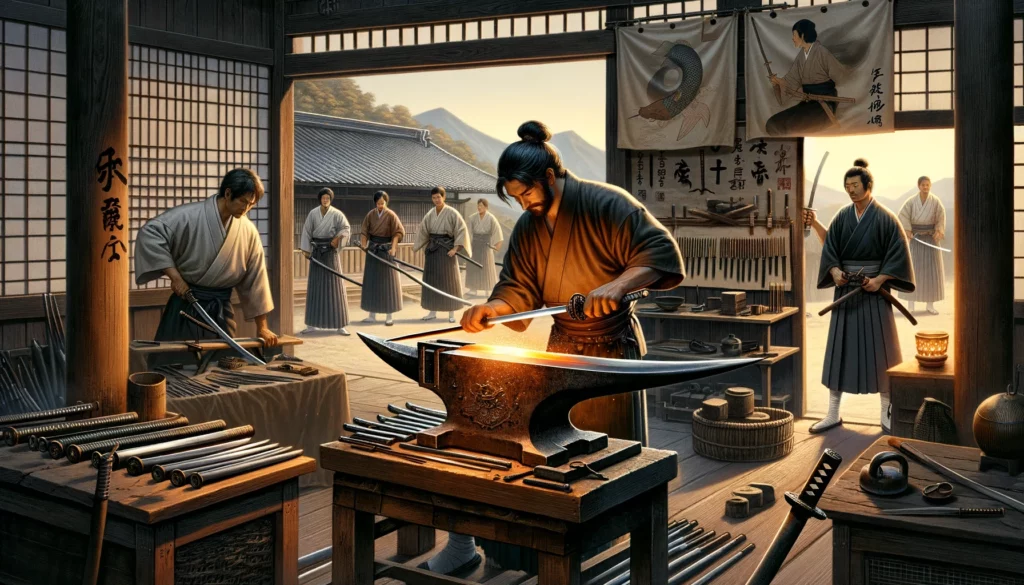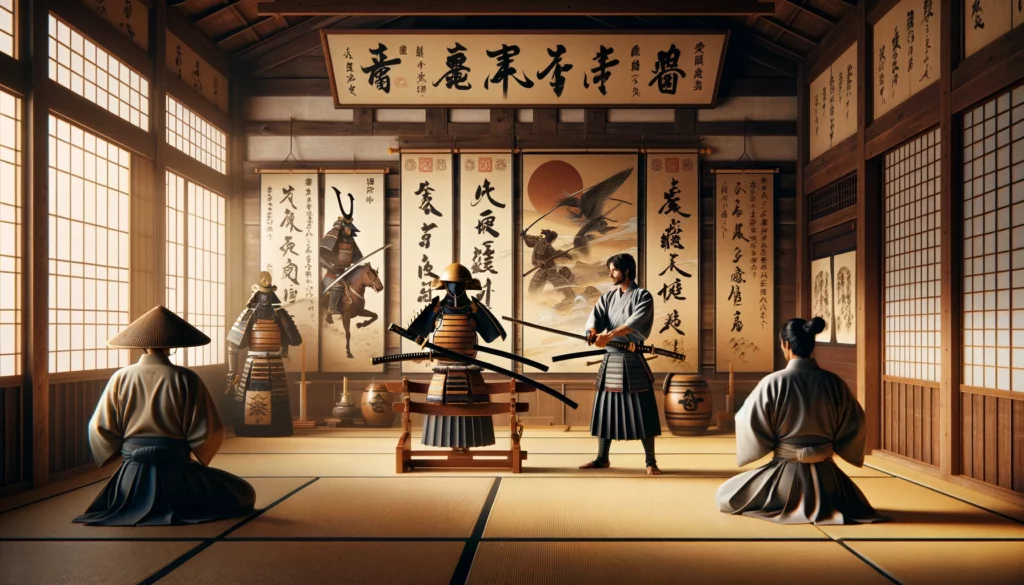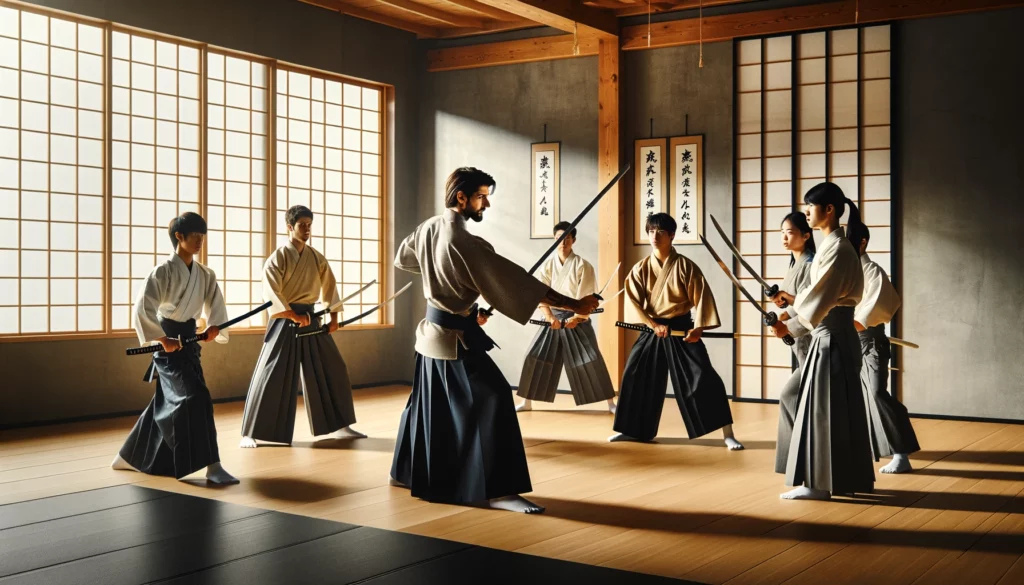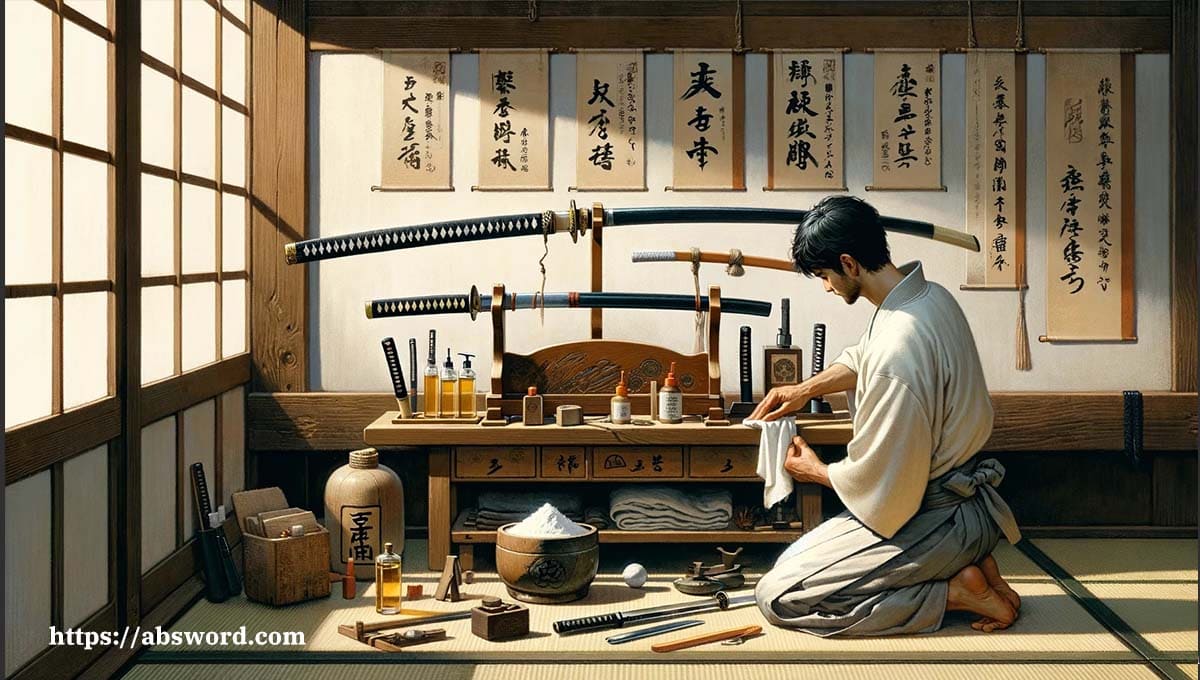Outline:
- Introduction
- Brief history and cultural significance of the katana.
- Overview of the rising interest in martial arts and swordsmanship.
- Understanding the Katana
- Anatomy of a katana: parts and their purposes.
- Variations in design and quality.
- Modern vs. traditional katanas.
- Historical Background
- Origins and development of the katana.
- The katana’s role in samurai culture.
- Evolution of swordsmanship schools (ryu).
- Philosophy and Ethics
- Bushido and the moral framework of the samurai.
- How modern katana training incorporates these principles.
- Mindset and discipline required for katana learning.
- Selecting Your First Katana
- Choosing a practice sword: iaito vs. shinken vs. bokken.
- Key factors to consider: weight, length, and budget.
- Importance of professional guidance.
- Basic Techniques and Practice
- Stances (kamae) and grips.
- Cutting techniques: kirioroshi, kesagiri, and yokogiri.
- Sheathing and drawing techniques (noto and nukitsuke).
- Basic kata and their significance.
- Training and Safety Guidelines
- Importance of proper instruction and supervision.
- Protective gear and equipment.
- Safety protocols during practice and demonstrations.
- Finding the Right Dojo
- Importance of proper instruction and dojo culture.
- Tips for finding a dojo with a good lineage.
- Questions to ask instructors.
- Katana Maintenance and Care
- Cleaning, oiling, and rust prevention.
- Checking for damage and sharpening techniques.
- Proper storage and display.
- Competitions and Advancement
- Overview of competitive formats (kata vs. kumite).
- Ranking systems and how to progress.
- Notable tournaments and organizations.
- Conclusion
- Encouragement for beginners to pursue katana learning.
- Emphasizing the benefits beyond technical skill.
- Call to action: join a dojo, buy your first katana, or take your training to the next level.

Article
1. Introduction
In recent years, the allure of martial arts has captivated people worldwide, and among the most fascinating aspects of this field is the katana. This iconic Japanese sword embodies more than a weapon; it is a symbol of historical artistry and the legendary spirit of the samurai. From video games to Hollywood movies, the katana stands as an emblem of discipline, precision, and skill. For beginners, understanding how to wield and respect this blade can open doors to an enriching practice that combines both mental and physical aspects.
This article will guide you through the essentials of katana learning, from understanding its rich history and structure to mastering basic techniques and philosophies that underpin this art. Whether you’re a history buff, an enthusiast of martial arts, or someone simply looking for a disciplined hobby, katana learning offers an experience that resonates on many levels.
2. Understanding the Katana
Before diving into the techniques and training, it’s crucial to understand the katana’s anatomy:
- Tsuka (Handle): Wrapped in a cord called “ito,” providing grip and control.
- Tsuba (Guard): Separates the handle from the blade, protecting the hands.
- Nagasa (Blade): Single-edged, curved steel that’s both durable and sharp.
- Habaki (Collar): A metal piece that secures the blade in the scabbard.
- Saya (Scabbard): Typically made of wood and finished with lacquer.
Each part plays a role in the katana’s functionality, from defensive protection to providing a balanced grip. Traditional katanas are hand-forged using tamahagane steel and require extensive skill to craft. Meanwhile, modern replicas often use different materials and methods to cater to varying needs, from display to actual practice.
3. Historical Background
The katana’s story begins in Japan’s Heian period (794-1185), with roots in tachi swords used by cavalry. These early blades were longer and straighter. The katana evolved as samurai warriors needed weapons suitable for quicker, one-handed drawing from the scabbard during close combat.
In the Edo period (1603-1868), swordsmanship became a cornerstone of samurai culture, leading to the development of various ryu (schools) that refined techniques and philosophies. The katana was more than a tool; it became a status symbol, embodying the samurai’s soul.
With the Meiji Restoration of the late 19th century and the subsequent abolition of the samurai class, the katana saw a decline in practical usage but rose as an art form. Today, katana training continues in the form of martial arts like Kendo, Iaido, and Kenjutsu.
4. Philosophy and Ethics
Learning the katana is not just about mastering techniques. It’s deeply intertwined with the principles of Bushido, or “The Way of the Warrior,” emphasizing loyalty, courage, and honor. Modern katana training still incorporates these virtues, demanding mental discipline as much as physical skill.
This philosophical aspect nurtures a mindset that respects the katana as more than a tool. It’s treated with reverence, understanding the historical and cultural significance it represents. Beginners will benefit greatly from incorporating these ideals, fostering focus and humility in their practice.
5. Selecting Your First Katana
Selecting your first practice sword is essential. Consider these main types:
- Bokken: A wooden sword for beginners and for practicing safe sparring.
- Iaito: An unsharpened katana, perfect for learning basic techniques.
- Shinken: A live, sharpened blade reserved for advanced practitioners.
Keep in mind:
- Weight and Length: Choose a katana appropriate for your build. Longer blades can be unwieldy for shorter people.
- Budget: High-quality katanas come at varying price points, but invest wisely for a durable sword.
- Guidance: Consult an experienced instructor to ensure your selection aligns with your training goals.

6. Basic Techniques and Practice
Mastering the basics is key to building a strong foundation.
- Stances (Kamae): Proper stances, like “chudan-no-kamae” (middle guard) or “gedan-no-kamae” (low guard), help maintain balance and readiness.
- Grips: Learn the two-handed grip with the right hand near the guard and the left hand towards the end of the handle.
- Cuts: Practice vertical (kirioroshi), diagonal (kesagiri), and horizontal (yokogiri) cuts with precision. Repetition builds muscle memory.
- Drawing and Sheathing: Techniques like nukitsuke (drawing) and noto (sheathing) are essential to wielding the katana swiftly and safely.
- Kata (Forms): Basic kata drills, like “mae” (front) and “ushiro” (rear), simulate combat situations and develop reflexes.
Consistent practice under expert guidance will help you refine these skills.
7. Training and Safety Guidelines
Proper instruction and supervision are vital. Here are some guidelines:
- Equipment: Ensure your katana, bokken, or iaito is in good condition. Use protective gear if practicing sparring.
- Protocol: Follow dojo etiquette and respect your instructor’s guidance.
- Environment: Train in a safe, spacious area free from obstructions.
- Supervision: Avoid solo practice with a live blade if you’re inexperienced.
Maintaining focus and respecting safety protocols will prevent injury and reinforce good habits.
8. Finding the Right Dojo
A good dojo offers quality instruction and a supportive environment.
- Lineage: Seek dojos with direct links to authentic ryu. This ensures proper teaching methods.
- Instructor Credentials: Verify instructors’ backgrounds and their ability to explain techniques and philosophy.
- Dojo Culture: A respectful, inclusive atmosphere is essential. Visit multiple dojos if possible.
Ask questions about teaching styles and the level of experience required to ensure the dojo matches your goals.
9. Katana Maintenance and Care
Maintaining your katana preserves its functionality and longevity.
- Cleaning: Use a cloth and a light oil (such as choji oil) to clean the blade after practice.
- Rust Prevention: Keep moisture away from the blade to prevent rusting.
- Damage Check: Look for bends, nicks, or cracks. Address these issues promptly.
- Sharpening: For live blades, sharpening should only be done by professionals.
- Storage: Store in a horizontal or angled position, ensuring it’s dry and away from dust.
Proper care demonstrates respect for the sword and keeps it ready for practice.
10. Competitions and Advancement
As you progress, consider the competitive aspects.
- Formats: Competitions often include kata (form) and kumite (sparring).
- Ranking: Many dojos follow ranking systems similar to other martial arts, indicating skill level.
- Tournaments: Events organized by organizations like the International Kendo Federation provide platforms to test skills.
While not obligatory, competition can be a valuable way to refine techniques and gain experience.
11. Conclusion
Katana learning is a journey that requires patience, dedication, and reverence for the art. Beyond technical skills, it builds character and instills virtues that transcend the dojo. Beginners are encouraged to explore this world, as it offers growth both mentally and physically.

Find a dojo, acquire a suitable practice sword, and embrace the journey ahead. The path of katana learning is challenging but rewarding, and every practitioner finds something valuable in its pursuit.

